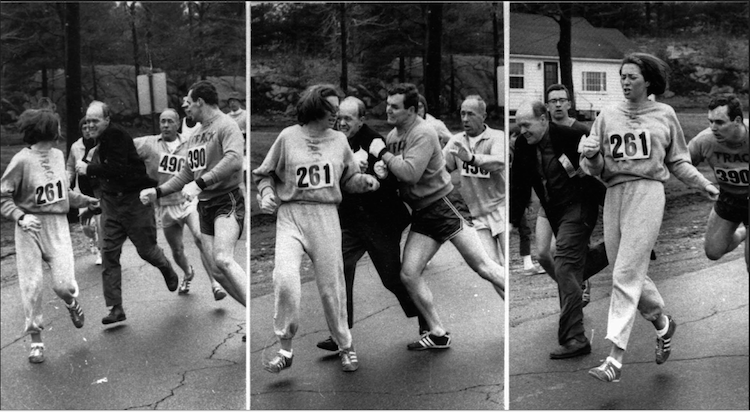The Boston marathon is being run today. One of the people broadcasting the race is Kathrine Switzer, as she has done for the past 37 years. But her connection to the race is far more groundbreaking.
In 1967, women were not allowed to run in marathons because of then-common beliefs (by the males who dominated sports bodies) about the risks posed to their supposedly fragile bodies. But women felt they were well up to the challenge and incensed by this exclusion, a few had slipped into races by jumping out of the bushes just beyond the starting line and running the distance. But since they were not officially entered and did not have numbers their performances did not count and they were not entered into the record books.
David Davis tells us the fascinating story of Switzer. Under the ambiguous name of K. V. Spitzer, she registered for the race and got the number #261. She was accompanied by her trainer (#490), her boyfriend (#390), and another male friend. Because she was wearing baggy sweatpants and sweatshirts on the cold day, the organizers did not notice that she was a woman until someone alerted one of them (Jock Semple) midway through the race, saying “Hey, Jock, you’ve got a broad on your hands today.”
What occurred then was captured in this extraordinary sequence of photographs. The two co-organizers of the race jumped off the journalists’ truck accompanying the runners and tried to grab her. After she evaded the first, the photos show Semple try to grab her and snatch the number bib off her chest in order to disqualify her, except that Switzer’s boyfriend running next to her threw a well-timed body check on the official and bounced him off the course, allowing her to escape from his clutches and finish the course
The photos were splashed all over the media and as a result of the publicity surrounding the whole event, major changes rapidly ensued.
In 1970, the Road Runners Club of America held the first women’s marathon championship (won by Sara Mae Berman). In 1971, the Western Hemisphere Marathon in California allowed women entrants, with Cheryl Bridges recording the landmark victory. The following year, Jock Semple [the official in the photo] opened the Boston Marathon to women, with Nina Kuscsik the winner. Switzer finished third.
On June 23, 1972, President Richard Nixon signed the Education Amendments of 1972 into law. One provision, Title IX, mandated more equitable treatment for female student-athletes, and women’s distance-running programs gradually became the norm. Finally, in 1984, the women’s marathon was added to the Olympic program. American Joan Benoit triumphed in Los Angeles, in 2:24:52, as she defeated Norway’s top-ranked Grete Waitz. Yet another all-male bastion had collapsed completely.
The full story told by Davis is quite fascinating. It is hard to imagine now how determined people were at one time to keep women out of some competitive athletic events.


“At one time”? 2010 isn’t that long ago.
It was only in 2002 that women were excluded from olympic bobsledding. And women’s ski jumpers had to file lawsuits in 2009 to get FIS recognition without which they’re no world championships, no olympics and no sponsorship. The FIS’s argument was that the impact of jumping might prevent women from becoming pregnant. I kid you not.
http://www.thenation.com/blog/178338/women-break-olympic-barrier-keep-reproductive-organs-intact
It’s a wonder women managed to survive so long with so fragile bodies.
It’s a good thing testicles are so naturally-well-armored and protected and unexposed to sport hazards…
Somebody should have told them about the Tarahumara people. Or, maybe someone did, but couldn’t get them to take their fingers out of their ears.
What, no MRAs showing up to denounce runner # 390 as a “white knight”?
One provision, Title IX, mandated more equitable treatment for female student-athletes…
I have been told (but don’t know where to look for supporting links) that during the Congressional debate over the Education Amendments of 1972 the gender language of Title IX was inserted -- to general laughter from our elected solons -- as an amendment to weaken the whole bill by reducing its expected support. Somehow in the give-and-take of legislating, the whole thing got enacted without the removal of that “poison pill”, with girl/woman athletes and their boosters taking it and running (so to speak …), with totally unanticipated and irreversible consequences.
Pierce,
I had not heard that. Intrigued, I looked it up and came up with this link that explains how the poison pill idea, which was a myth, came about.
Kathrine Switzer wrote an account herself for Runners’ World here:
http://kathrineswitzer.com/site/wp-content/uploads/SwitzerStory_RunnersWorld.pdf
Mano Singham @ # 6 -- Yabbut your link concerns Title VII of the Civil Rights Act of 1964, not Title IX of the Education Amendments Act of eight years later. The stories do seem suspiciously similar, so I did my own little search, which at first came up with only this:
-- so that connects some of the dots.
The Feminist Majority Foundation says
I have little doubt that the FMF would report on the sorts of shenanigans I had thought had occurred, so this (to me) confirms your conclusion.